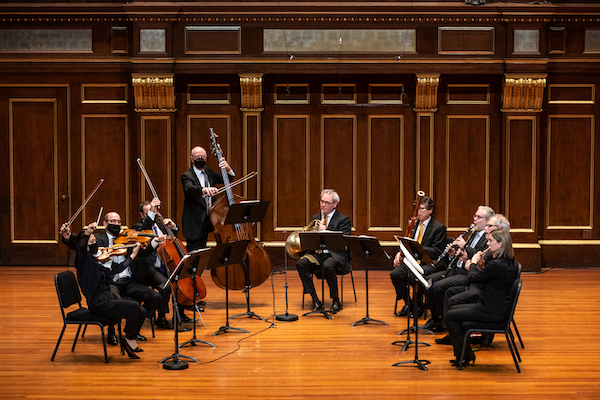Farrenc, Epstein works highlight the return of Boston Symphony Chamber Players

The Boston Symphony Chamber Players performed Louise Farrenc’s Nonet Sunday afternoon at Jordan Hall. Photo: Robert Torres
This past weekend was a good one for fans of Louise Farrenc, the 19th-century French composer whose music is finally being reconsidered after 150 years of neglect. On Friday, the Handel and Haydn Society brought her Symphony No. 3 into their repertoire. And Sunday afternoon, the Boston Symphony Chamber Players followed suit with Farrenc’s Nonet.
The 1849 piece was the capstone of the BSCP’s first live concert at Jordan Hall in nearly two years. And their program reflected a slow shift in attitudes towards the canon: the afternoon’s offerings were all written by women. Farrenc was, if you will, the concert’s grande dame; the remaining selections were by Jennifer Higdon, Marti Epstein, and Shulamit Ran.
Fittingly, the Nonet was the most substantial of the BSCP’s offerings. While, stylistically and structurally, it references the models of Haydn, Mozart, Beethoven, and Mendelssohn, nothing about Farrenc’s writing is derivative.
The melodic lines are fluent, counterpoint vivid. Her scoring—for flute, oboe, clarinet, bassoon, horn, violin, viola, cello, and double bass—is breathtakingly idiomatic. Indeed, over the Nonet’s thirty-minute duration, everyone gets multiple opportunities to shine, particularly during the inimitable second-movement variations and droll, third-movement Scherzo.
Sunday’s reading was appropriately warm and sweeping, the first movement’s introduction nobly weighted and expressive, while its graceful main body danced pertly. Though periodically covered by her colleagues, violinist Ayano Ninomiya’s solos wanted nothing for beauty of tone or accuracy of pitch—especially in the brilliant cadenza just before the movement’s close.
The second drew out further bravura playing from Ninomiya, this time in conjunction with violist Steven Ansell, during their second-variation exchanges. Ansell, oboist John Ferrillo, and cellist Blaise Déjardin were likewise well-matched in their back-and-forth during the movement, while hornist James Sommerville dispatched his virtuosic turns in the minore variation with aplomb.
In the Scherzo, the ensemble nimbly emphasized the music’s chiaroscuro. Meanwhile, the gracious finale unfolded as a masterclass in elegant, collegial playing, especially its vigorously personable coda.
Similar qualities emerged, here and there, in the BSCP’s account of Higdon’s Autumn Music.
Written in 1995, this woodwind quintet is a tribute to Samuel Barber’s similarly titled Summer Music. It begins boisterously, with trills and lively thematic ideas bouncing off one another. Over its second half, some shapely, Barber-esque melodies emerge and, as the scoring descends towards the abyss (oboe and clarinet are exchanged for, respectively, English horn and bass clarinet), the piece expires reflectively.
On Sunday, the players captured its broad outlines well: flutist Elizabeth Rowe’s low-register playing near the end was winsomely burnished, as were Ryan Yuré’s bass clarinet turns.
Yet textures were occasionally cloudy and the music’s dynamic range limited. Accordingly, its larger impression was somewhat muddy.
A similar balancing issue emerged in Ran’s Lyre of Orpheus, though here it went in the opposite direction: violinists Ninomiya and Omar Chen Guey didn’t project to the same degree as violists Ansell and Cathy Basrak or cellists Déjardin and Oliver Aldort.
The result wasn’t exactly a dispassionate account of Ran’s gripping 2008 sextet: the group captured the music’s shifts between sumptuous expressivity and bold declamation well, and they capably drew out its range of colors (especially Ran’s varied uses of sul ponticello articulations). But the reading’s big moments all felt a mite off-balance.
No such problems emerged, though, in Epstein’s Komorebi. A 2017 trio for oboe, clarinet, and violin, the piece is a study in subtly shifting colors (the title is a Japanese word that describes sunlight shining through the leaves of a tree).
Gently leaping lines gradually coalesce, becoming more unified, consonant, and shaded as the music proceeds; later they splinter. Everything is spare and delicate, the dynamic range often on the softer end of the spectrum.
Sunday’s performance, which featured Ferrillo and Ninomiya alongside clarinetist William R. Hudgins, was captivating. The ensemble’s tonal purity, textural transparency, and spotless intonation culminated in an interpretation at once exquisitely beautiful and rivetingly intense.
Epstein was on hand to accept the audience’s cordial ovation.
The Boston Symphony Chamber Players perform music by Belá Bartók, Michael Gandolfi, and Antonin Dvořák 3 p.m. January 23. bso.org.
Posted in Performances